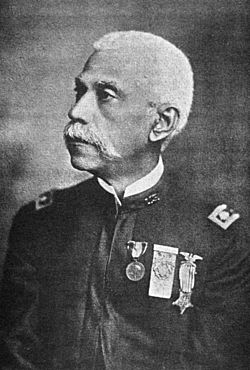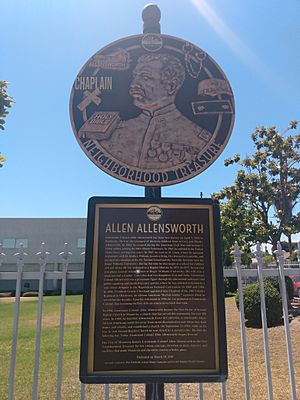Allen Allensworth facts for kids
Quick facts for kids
Lt. Col. Allen Allensworth
|
|
|---|---|
 |
|
| Born | 7 April 1842 Louisville, Kentucky |
| Died | 14 September 1914 (aged 72) Monrovia, California |
| Place of burial | |
| Allegiance | |
| Service/ |
United States Navy, United States Army |
| Rank | Lieutenant colonel |
| Other work | Founder, Allensworth, California |
Allen Allensworth (born April 7, 1842 – died September 14, 1914) was an amazing American who achieved many things. He was born into slavery in Kentucky. During the American Civil War, he bravely escaped to freedom.
He then joined the Union Army as a soldier. Later, he became a Baptist minister and a teacher. He was even chosen to be a chaplain in the United States Army. Allensworth made history as the first African American to become a lieutenant colonel. He helped start many churches. In 1908, he founded Allensworth, California. This was the only town in California started, paid for, and run by African Americans.
During the Civil War, he escaped by joining the 44th Illinois Volunteers. He later served two years in the Navy. After becoming a minister, he taught and led several churches. He was the only black delegate from Kentucky at the Republican National Conventions in 1880 and 1884. In 1886, he became a military chaplain for the Buffalo Soldiers in the West. He served in the U.S. Army for 20 years, retiring in 1906.
Besides his church work, he is famous for founding Allensworth, California in 1908. He wanted it to be a community just for black people. The town faced challenges with its environment. But much of the old town is now saved as the Colonel Allensworth State Historic Park. It reminds us of the founders' dream and the strong community that grew there for a time.
Contents
Who Was Allen Allensworth?
His Early Life and Education
Allen Allensworth was born into slavery in Louisville, Kentucky in 1842. He was the youngest of 13 children. His family was often separated. Some of his older brothers were sold to plantations in the Deep South. His sister Lila escaped to Canada using the Underground Railroad. His sister Mary Jane bought her freedom in 1849.
Allen's mother was owned by A.P. and Bett Starbird. Mrs. Starbird made Allen a young slave for her son, Thomas. When Thomas went to school, Allen secretly learned from him. This was against the law for enslaved people. After his father died, Allen's mother chose to be sold to a neighbor, Nat Wolfe.
When the Starbirds found out Allen was learning to read, they stopped him. They sent him to another family, the Talbots. Mrs. Talbot was a Quaker and was kind to Allen. She kept teaching him to read and write. She also took him to a Sunday school for slave children. When Bett Starbird found out, she took Allen back. In 1854, she sent him to a plantation in Henderson, Kentucky. She wanted to stop him from learning.
On the steamboat, Allen was cared for by a slave steward. He was not chained with other slaves. These slaves were being taken to be sold. Allen's new mistress, Hebe Smith, made him a houseboy. She told him not to study and whipped him when he tried. Allen became friends with a white orphan boy named Eddie. They helped each other.
In 1855, at age 13, Allen tried to escape to Canada. He hid for two weeks but had to return. Later, he ran away again. The Smiths and Starbirds decided to sell him at an auction.
Allensworth was sold again in Memphis, Tennessee. He was then sent to New Orleans. There, Fred Scruggs bought him. Scruggs taught him to be an exercise boy and jockey. Unlike others, Scruggs was happy that Allen could read. He assigned Allen to race his best horse.
Freedom During the Civil War
In early 1861, the American Civil War was about to begin. Horse racing still continued. Scruggs took Allen and his horses to Louisville. Allen hoped to see his mother, Phyllis. He learned she had been freed. She had gone to New Orleans to find her sons.
While working on a nearby farm, Allensworth met Union soldiers. They were from the 44th Illinois Volunteer Infantry Regiment. He told them he wanted to be free. They invited him to join their Hospital Corps. He dressed in disguise and marched with the soldiers through Louisville.
He worked as a civilian nursing aide. Later, he went with a surgeon, Dr. A. J. Gordon, to his home in Georgetown, Ohio. There, Allensworth felt truly free for the first time. In 1863, he joined the U.S. Navy. He earned his first pay as a free man. He was soon promoted to Captain's steward and clerk. He served on gunboats for two years.
Life After the War
After the war, Allensworth returned to Kentucky to work and study. In 1868, he joined his brother William in St. Louis. They ran two restaurants. They sold them quickly, and Allensworth went back to Louisville. He worked to pay for his studies at the Ely Normal School. This was a new school for African Americans.
During the Reconstruction period, Allensworth taught at schools for freed people. These schools were run by the Freedmen's Bureau. He was inspired by teaching. He started taking classes at the Nashville Institute, now called Roger Williams University. He did not graduate but later received an honorary Master of Arts degree.
Allensworth became involved with the Baptist Church in Louisville. He was ordained as a preacher in 1871. In the 1870s, he studied theology in Tennessee. He also served as a preacher in Franklin, Tennessee.
In 1875, Allensworth taught in Georgetown, Kentucky. He also helped manage money for the Colored Baptists in Kentucky. They worked together to start a religious school for black teachers and preachers. Allensworth helped found The State University. He also served on its Board of Trustees.
He returned to Louisville to lead the Harney Street Baptist Church. He helped it grow a lot. They renamed it Centennial Baptist Church. It became a model church. Allensworth increased the church's members almost five times. They built a new church building.
His Family Life
In 1877, Allen Allensworth married Josephine Leavell (1855–1938). They met while studying at Roger Williams University in Nashville, Tennessee. Josephine was a talented pianist, organist, and music teacher. They had two daughters, Eva and Nella.
The year he married, Allensworth invited his mother to live with them. She lived with them for several months before she passed away in 1878 at age 96.
A Leader in the Post-Reconstruction Era
Allensworth became a pastor at the State Street Church in Bowling Green, Kentucky. He also gave public talks. He went to Boston to give a series of lectures. He had studied public speaking in Philadelphia.
When he returned, he met people from the American Baptist Publication Society. They made him a Sunday School Missionary for Kentucky. He always worked to improve Sunday Schools. This new role let him continue his education work across the state. He was also named State Sunday School Superintendent by the Colored Baptist State Sunday School Convention of Kentucky.
With his leadership and public speaking, Allensworth became interested in politics. In 1880 and 1884, he was chosen as Kentucky's only black delegate to the Republican National Conventions.
Military Career as a Chaplain
In 1886, when Allensworth was 44, he received support from politicians to become a chaplain in the U.S. Army. His appointment was approved by the Senate and the president. He was one of the few black chaplains in the U.S. Army. He was assigned to the 24th Infantry Regiment, known as the Buffalo Soldiers.
His family traveled with him to different assignments in the West. These included Fort Bayard, New Mexico Territory, Fort Supply, Indian Territory, and Fort Harrison, near Helena, Montana. His wife played the organ in the fort chapels.
At Fort Bayard, Allensworth wrote a guide for studies and rules for post schools. The Army later used these as a standard manual for educating soldiers.
When he retired in 1906, Allensworth had been promoted to lieutenant colonel. He was the first African American to reach this rank.
Allensworth, California: A Dream Town
After leaving the army, Allensworth and his family settled in Los Angeles, California. He had a big idea: to create a self-sufficient, all-black community in California. He wanted a place where African Americans could live without the racial discrimination common in America after the Civil War. His dream was to build a community where black people could live freely and create "a feeling that helps thinking and working freedom."
In 1908, he founded Allensworth in Tulare County. This was about 30 miles north of Bakersfield. The black settlers in Allensworth built homes and streets. They put up public buildings. They started a church and formed an orchestra, a glee club, and a brass band.
The Allensworth community became part of the county school district. It also joined the regional library system and became a voting precinct. Residents elected the first African-American Justice of the Peace in California after it became part of the U.S. In 1914, a newspaper reported that the Allensworth community had 900 acres of land. This land was worth over US$112,500.
Allensworth quickly grew into a real town. Many social and educational groups thrived there. These included the Campfire Girls, the Owl Club, the Girls' Glee Club, and the Children's Savings Association for younger residents. Adults had a Sewing Circle, Whist Club, Debating Society, and Theater Club.
Colonel Allensworth admired Booker T. Washington, a famous African-American educator. Washington was the founder of the Tuskegee Institute in Alabama. Allensworth hoped his new community could be self-sufficient. He wanted it to be known as the "Tuskegee of the West."
The Girls' Glee Club was inspired by the Fisk Jubilee Singers from Fisk University. They were the pride of the community. All the streets in the town were named after important African Americans or white abolitionists. These included Sojourner Truth, Frederick Douglass, poet Paul Laurence Dunbar, and Harriet Beecher Stowe.
Allensworth is the only California community founded, paid for, and run by African Americans. The founders wanted to improve life for African Americans. However, problems like a drop in the water level led to the town's decline. The dry soil made farming hard. The drinking water also became unsafe because of arsenic.
Allensworth's Legacy and Honors
- The state of California has saved the town site. They are slowly restoring its buildings. The most important building is the schoolhouse. It was used until 1972. It is furnished as it would have been in 1915.
- The park holds special events to celebrate the town's history. The visitor center shows a film about the site. An annual ceremony honors the vision of the original pioneers.
- Colonel Allensworth's home is also preserved. It is decorated in the style of 1912. It has items from his military and ministry life. A small display of farm equipment reminds visitors of the town's farming past.
- A public monument for Allen Allensworth was designed by Ron Husband. It was paid for by the City of Monrovia, California.
His Death
Allen Allensworth died at age 72 on September 14, 1914. He was killed by a motorcyclist in Monrovia, California. The downtown area is now preserved as Colonel Allensworth State Historic Park. Thousands of visitors come each year for special events. The area outside the state park is still lived in today.
Colonel Allensworth was buried at Angelus-Rosedale Cemetery in Los Angeles, California.



